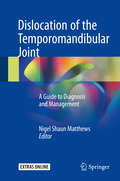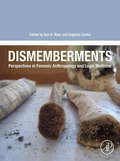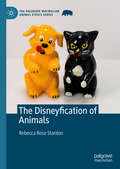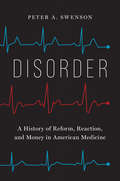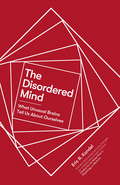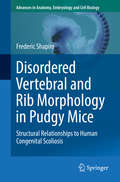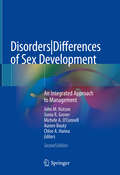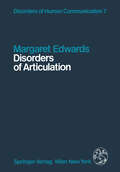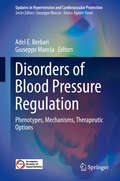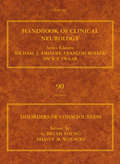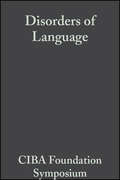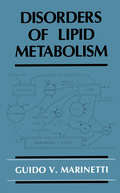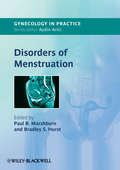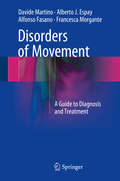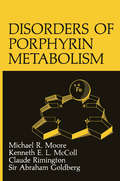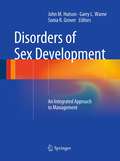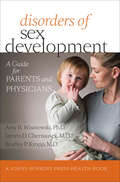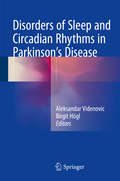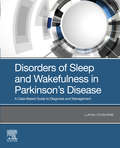- Table View
- List View
Dislocation of the Temporomandibular Joint: A Guide to Diagnosis and Management
by Nigel Shaun MatthewsThis book provides a comprehensive overview of dislocation of the temporomandibular joint (TMJ), covering all relevant aspects, from aetiology and diagnosis to management. The treatment-oriented chapters describe nonsurgical, surgical and arthroscopic interventions, and the book closes by examining the role of total alloplastic reconstruction of the TMJ in patients with chronic jaw joint dislocation. Each chapter commences with a summary of key points and the clearly written text is supported by numerous clinical photographs, as well as by videos to which the reader will have online access. All of the authors are recognized experts in the topics that they discuss. Dislocation of the TMJ constitutes a medical emergency since prompt treatment is required in order to prevent the harmful sequelae that may arise once spasm of the muscles of mastication has become established, preventing return of the condyle into the glenoid fossa. If the condition is left untreated, radical corrective surgery may be required to restore jaw function and eliminate pain. In presenting state of the art knowledge on TMJ dislocation, this book will be of value for all involved in the management of the condition.
Dismantling the NHS?: Evaluating the impact of health reforms
by Mark Exworthy Russell MannionThis book provides an in-depth analysis of the NHS reforms ushered in by UK Coalition Government under the 2012 Health and Social Care Act, arguably the most extensive reforms ever introduced in the NHS. Contributions from leading researchers from the UK, the US and New Zealand examine the reforms in the contexts of national health policy, commissioning and service provision, governance and others. Collectively, the chapters presents a broader assessment of the trajectory of health reforms in the context of marketisation, the rise of health consumerism and the revelation of medical scandals. This is essential reading for those studying the NHS, those who work in it, and those who seek to gain a better understanding of this key public service.
Dismantling the NHS?: Evaluating the impact of health reforms
by Mark Exworthy Russell MannionThis book provides an in-depth analysis of the NHS reforms ushered in by UK Coalition Government under the 2012 Health and Social Care Act, arguably the most extensive reforms ever introduced in the NHS. Contributions from leading researchers from the UK, the US and New Zealand examine the reforms in the contexts of national health policy, commissioning and service provision, governance and others. Collectively, the chapters presents a broader assessment of the trajectory of health reforms in the context of marketisation, the rise of health consumerism and the revelation of medical scandals. This is essential reading for those studying the NHS, those who work in it, and those who seek to gain a better understanding of this key public service.
Dismemberments: Perspectives in Forensic Anthropology and Legal Medicine
by Ann H. Ross Eugénia CunhaDismemberments: Perspectives in Forensic Anthropology and Legal Medicine is the only volume in the field to address the complexities of interpreting dismemberment trauma, the different tools used, and the sociocultural motives behind dismemberments. The book's goal is to provide the reader with a comprehensive assessment that covers all aspects of dismemberment, from means and motive, to toolmark and instrument identification, to disarticulation and re-association of body parts. Each chapter is written by internationally known, expert contributors from around the world. Users will find this to be is a great resource for those involved in the analysis of recovered human remains. Presents a comprehensive volume on trauma examination and reconstruction in complex dismemberment casesIncludes contributions by world renowned specialists in forensic anthropology and legal medicineProvides case studies throughout the volume to aid with understanding
The Disneyfication of Animals (The Palgrave Macmillan Animal Ethics Series)
by Rebecca Rose StantonThis book critically examines how Walt Disney Animation Studios has depicted – and sometimes failed to depict – different forms of harming and objectifying non-human animals in their films. Each chapter addresses a different form of animal harm and objectification through the theories of speciesism, romanticism, and the ‘collapse of compassion’ effect, from farming, hunting and fishing, to clothing, work, and entertainment. Stanton lucidly presents the dichotomy between depictions of higher order, anthropomorphised and neotonised animal characters and that of lower-order species, showing furthermore how these depictions are closely linked to changing social attitudes about acceptable forms of animal harm. An engaging and novel contribution to the field of Critical Animal Studies, this book explores the use of animals not only in Disney’s best known animated films such as 101 Dalmatians, but also lesser known features including Home on the Range and Fun and Fancy Free. A quantitative appendix supplying data on how often each animal species appears and the amount of times animal harm or objectification is depicted in over fifty films provides an invaluable resource and addition to scholars working in both Disney and animal studies.
Disorder: A History of Reform, Reaction, and Money in American Medicine
by Peter A. SwensonAn incisive look into the problematic relationships among medicine, politics, and business in America and their effects on the nation’s health Meticulously tracing the dramatic conflicts both inside organized medicine and between the medical profession and the larger society over quality, equality, and economy in health care, Peter A. Swenson illuminates the history of American medical politics from the late nineteenth century to the present. This book chronicles the role of medical reformers in the progressive movement around the beginning of the twentieth century and the American Medical Association’s dramatic turn to conservatism later. Addressing topics such as public health, medical education, pharmaceutical regulation, and health-care access, Swenson paints a disturbing picture of the entanglements of medicine, politics, and profit seeking that explain why the United States remains the only economically advanced democracy without universal health care. Swenson does, however, see a potentially brighter future as a vanguard of physicians push once again for progressive reforms and the adoption of inclusive, effective, and affordable practices.
Disordered Defaecation: Current opinion on diagnosis and treatment (Developments in Surgery #8)
by H. O. Ten Cate HoedemakerThe Disordered Mind: What Unusual Brains Tell Us About Ourselves
by Eric R. Kandel'[Kandel's discoveries] have truly changed our understanding of brain function' - Citation for the Nobel Prize in Physiology or Medicine'[Eric Kandel is] one of the preeminent neuroscientists in the world' - Sue Halpern, The New York Review of Books Neurological and psychiatric disorders have long been regarded as fundamentally different, depending on whether they appear to affect the brain or the mind. In reality, the brain and the mind are inseparable. Both types of disorder can affect every aspect of brain function: from perception, action, memory and emotion to empathy, social interaction, attention and consciousness. It is easy to view brain disorders as simply tragic or frightening. However, studying where these functions go wrong provides a window on the workings of the healthy brain, and makes it more likely that scientists and clinicians will be able to develop effective treatments or preventative strategies. As individuals, and as a society, we are also able to better empathise with people with disorders of the mind.Building on his pioneering research, Eric R. Kandel illustrates how breakthrough studies of brain disruptions can deepen our understanding of thought, feeling, behaviour, memory and creativity, and perhaps in the future will transform medical care and lead to the development of a unified theory of mind.
Disordered Systems and Biological Organization: Proceedings of the NATO Advanced Research Workshop on Disordered Systems and Biological Organization held at Les Houches, February 25 – March 8, 1985 (NATO ASI Subseries F: #20)
by E. Bienenstock F. Fogelman Soulie G. WeisbuchThe NATO workshop on Disordered Systems and Biological Organization was attended, in march 1985, by 65 scientists representing a large variety of fields: Mathematics, Computer Science, Physics and Biology. It was the purpose of this interdisciplinary workshop to shed light on the conceptual connections existing between fields of research apparently as different as: automata theory, combinatorial optimization, spin glasses and modeling of biological systems, all of them concerned with the global organization of complex systems, locally interconnected. Common to many contributions to this volume is the underlying analogy between biological systems and spin glasses: they share the same properties of stability and diversity. This is the case for instance of primary sequences of biopo Iymers I ike proteins and nucleic acids considered as the result of mutation-selection processes [P. W. Anderson, 1983] or of evolving biological species [G. Weisbuch, 1984]. Some of the most striking aspects of our cognitive apparatus, involved In learning and recognttlon [J. Hopfield, 19821, can also be described in terms of stability and diversity in a suitable configuration space. These interpretations and preoccupations merge with those of theoretical biologists like S. Kauffman [1969] (genetic networks) and of mathematicians of automata theory: the dynamics of networks of automata can be interpreted in terms of organization of a system in multiple possible attractors. The present introduction outlInes the relationships between the contributions presented at the workshop and brIefly discusses each paper in its particular scientific context.
Disordered Vertebral and Rib Morphology in Pudgy Mice: Structural Relationships to Human Congenital Scoliosis (Advances in Anatomy, Embryology and Cell Biology #221)
by Frederic ShapiroThis book presents results obtained from the whole mount preparations, radiological, and histological studies of 60 pu/pu and pu/+ mice from late embryo until 3 months of age. Most mice were in the embryo to 6 week age group where vertebral developmental changes are most marked. Although vertebral abnormalities have been identified as due to mutations in the delta-like 3 (Dll3) gene, it is evident that each mouse has differing structural abnormalities. The disorder is analogous to human congenital scoliosis, a common variant of which is spondylocostal dysplasia. The histological studies presented in this book include plastic embedded sections which allow for high level resolution not only of vertebrae, intervertebral discs, and ribs but also of associated spinal cord, nerve roots and ganglia. In addition an overview of embryo and neonatal development in mouse, chick and human vertebrae is provided to better assess how and where deviant pathoanatomy occurs. The book discusses the possible variables involved in creating final deformity beyond the gene abnormality itself.
Disorders and Interventions
This comprehensive text provides a systematic explanation of major conditions such as cancer, coronary heart disease, stroke and hypertension. It starts with a definition and then examines the epidemiology, aetiology and pathophsyiology of the disorder as well as clinical signs, symptoms and treatments. Interventions to be made at various levels are explored, and clinical practice points are offered. This is essential reading for students and health professionals wishing to further their understanding of common disorders and to improve their delivery of care.
Disorders|Differences of Sex Development: An Integrated Approach to Management
by John M. Hutson Sonia R. Grover Michele A. O’Connell Aurore Bouty Chloe A. HannaThe new, fully updated edition of this successful book, brings together the combined experience of a leading dedicated unit over 25 years in delivering expert medical and surgical care to children with DSD (Disorders|Differences of Sex Development) in a holistic environment. It documents the most recent advances in the molecular biology and embryology of sex development, and describes each variation in detail. The main focus of the book is on patients with variations with their anatomy and hormone function. New chapters describe the developments in the field in terms of definitions and incidence, the mental health of DSD patients and discuss the perspectives of patients families and support groups. The clinical presentation and approach to diagnosis are described both for babies and for children presenting later in childhood or at adolescence. The chapters on management highlight all the latest knowledge and include the shared wisdom of the authors on current controversies, such as the timing of surgical treatment. Finally, the authors describe their short-, medium-, and long-term outcomes, which demonstrate the strengths of holistic team management.
Disorders of Articulation: Aspects of Dysarthria and Verbal Dyspraxia (Disorders of Human Communication #7)
by Margaret EdwardsThe title of this book may at first appear to be somewhat restrictive in its use of terminology. However, this is far from the intention of the writer; on the contrary, the following chapters seek to reflect a departure from the traditional segmentally orientated approach to this type of disability. Indeed one reason why the book has been written is the sense of frustration arising out of the largely ineffectual static and structural methodology of remedial work. Alternative titles could have been Disorders of Speech Production, or Neurogenic Speech Disorders, but neither would have encapsulated the essence of the book. Much of the recent research in the neurophysiology of motor control and also in the field of neurolinguistics has been concerned with ways in which intention and planning of movement is effected. Such models are still in their infancy, but it seems the potential value of their application to speech is considerable. In the case of verbal dysp'taxia, for example, we have long since in rather vague terms described it as a disorder of organization and programming without ever stating exactly what may be disorganized or not properly planned. This book does not provide the answer for as yet there is insufficient data on which to work so that formulated theories may be tested and further defined. But as we move from speculative guess-work towards established fact so the likelihood grows of providing more positive help for those who suffer these drastic limitations in communication.
Disorders of Blood Pressure Regulation: Phenotypes, Mechanisms, Therapeutic Options (Updates in Hypertension and Cardiovascular Protection)
by Adel E. Berbari Giuseppe ManciaThis book aims to present a comprehensive classification of hypertensive phenotypes based on underlying target organ involvement. Particular emphasis is placed on review and assessment of clinical presentation, pathophysiologic mechanisms, and possible specific therapeutic options for each hypertension phenotype. Several of these phenotypes are well known and well described in the literature, such as prehypertension, white coat and masked hypertension, isolated systolic hypertension, renovascular hypertension, endocrine hypertension, pediatric hypertension, and gestational hypertension. Other hypertension phenotypes, however, are not widely recognized, being reported only in special reviews; examples include hypertension associated with renal calculus disease and other rarer causes such as Turner syndrome, herbal and medicinal compounds, and pharmacologic agents. A detailed account of the various causes of monogenic hypertension is also included. Finally, a section is devoted to general aspects of hypertension, including the significance of blood pressure indices, the natural course of untreated and treated hypertension, hypertension mechanisms, genetics, and guidelines for blood pressure control.
Disorders of Consciousness (ISSN #Volume 90)
by G. Bryan Young WijdicksThis volume encompasses a variety of topics pertaining to patients with altered levels of consciousness, including valuable differences between disorders. Neurologists, researchers, and clinicians will find a comprehensive accounting of the distinctions between disorders that cause these altered states. Beginning with basic concepts of consciousness and neurobiology, this handbook progresses into more targeted and complex areas of discussion, including important technological advancements that have occurred in neuroimaging. Neurologists who are frequently called upon for prognostication and to guide management of patients with these disorders will find invaluable information, including chapters discussing comatose states in children and pregnant women, encephalopathic patients, nutrition disorders, and vegetative and minimally conscious states. In addition, chapters devoted to philosophical backgrounds and ethical implications involving patients with impaired consciousness, are thoroughly presented. * A comprehensive reference guide that progresses from basic concepts of consciousness and neurobiology to targeted, complex topics of discussion* Invaluable information on new technological advancements that have occurred in neuroimaging, thus furthering diagnostic and treatment modalities* Philosophical and ethical implications involving the relationship between clinicians and patients with impaired levels of consciousness
Disorders of Language (Novartis Foundation Symposia)
by A. V. S. De Reuck Maeve O'ConnorThe Novartis Foundation Series is a popular collection of the proceedings from Novartis Foundation Symposia, in which groups of leading scientists from a range of topics across biology, chemistry and medicine assembled to present papers and discuss results. The Novartis Foundation, originally known as the Ciba Foundation, is well known to scientists and clinicians around the world.
Disorders of Lipid Metabolism
by G.V. MarinettiFor the past 30 years I have been teaching lipid biochemistry to'inedical students, graduate students, and undergraduate students. The major topics covered in my courses were fatty acids, prostaglandins, leukotrienes, phospholipids, glyco lipids, triacylglycerols, cholesterol, bile acids, and plasma lipoproteins. Empha sis was placed on the regulation and disorders of lipid metabolism. The latter included hyperlipidemias, atherosclerosis, and alcohol-induced liver damage. In this volume, I have chosen to focus on the disorders of lipid metabolism at a level appropriate both for medical students and for graduate and undergradu ate students majoring in the biological sciences. The biochemistry, nutrition, genetics, and cell biology aspects of lipids and lipid metabolism will be covered as they relate to lipid disorders. I am not aware of any textbook that integrates the disorders of lipid metabolism in this manner. Chapter 1 includes a brief discussion of the basic structures, properties, and metabolism of lipids. This chapter is not very detailed, since the material covered is available in basic textbooks on biochemistry. The major fpcus of this volume is the various lipid disorders, with emphasis on polyunsaturated fatty acids, the molecular biology and pathogenesis of the hyperlipidemias, dietary and drug therapy for the hyperlipidemias, and alcohol-induced liver damage. The material presented has been obtained from several textbooks on biochemistry and from a variety of recent articles in the scientific literature.
Disorders of Menstruation
by Paul Marshburn Bradley HurstLearn how to interpret menstrual cycle events as vital signs for women. Irregularities in the pattern and amount of vaginal bleeding of uterine origin are often signs of pathology or an aberration in the function of the hypothalamic, pituitary, and ovarian system. The type of menstrual disorder when coupled to the women's age can give important signals as to the likely problem. Disorders of Menstruation follows the reproductive lifetime of women, from prepubertal abnormalities through the years of potential child bearing to menopause and beyond. The authors provide a conceptual framework to understand the mechanisms responsible for abnormal menstrual bleeding or early pregnancy failure. This clinically focused book is written for any practicing clinician who provides healthcare for girls and women. Disorders of Menstruation highlights accurate diagnostic algorithms that lead to evidence-based therapy or minimally invasive surgery using approaches that are practical, efficient, and cost-effective. A new addition to the Gynecology in Practice series.
Disorders of Menstruation (Gip - Gynaecology In Practice Ser. #12)
by Paul Marshburn Bradley HurstLearn how to interpret menstrual cycle events as vital signs for women. Irregularities in the pattern and amount of vaginal bleeding of uterine origin are often signs of pathology or an aberration in the function of the hypothalamic, pituitary, and ovarian system. The type of menstrual disorder when coupled to the women's age can give important signals as to the likely problem. Disorders of Menstruation follows the reproductive lifetime of women, from prepubertal abnormalities through the years of potential child bearing to menopause and beyond. The authors provide a conceptual framework to understand the mechanisms responsible for abnormal menstrual bleeding or early pregnancy failure. This clinically focused book is written for any practicing clinician who provides healthcare for girls and women. Disorders of Menstruation highlights accurate diagnostic algorithms that lead to evidence-based therapy or minimally invasive surgery using approaches that are practical, efficient, and cost-effective. A new addition to the Gynecology in Practice series.
Disorders of Movement: A Guide to Diagnosis and Treatment
by Davide Martino Alberto J. Espay Alfonso Fasano Francesca MorganteThis concise but comprehensive book will help interested readers in the health care professions to navigate their way through the jungle of movement disorders, including the potentially complex differential diagnosis and management. The different disorders are discussed in individual sections that explain how to examine the patient and recognize the disorder from its basic phenomenology, how to confirm a diagnosis, how to distinguish a particular disorder from related conditions, and how to treat each disorder effectively. The book makes liberal use of diagrams, algorithms, tables, summary boxes, and illustrations to facilitate solution of clinical problems at the bedside and to solidify previously learned clinical and therapeutic concepts. It will be of interest to a broad audience of health professionals, scientists, and medical students.
Disorders of Porphyrin Metabolism (Topics in Hematology)
by A. Goldberg K.E.L. McColl M.R. Moore C. RimingtonEach of the four authors of this book has a particular interest in disorders of porphyrin metabolism and special experience in their management. Their individual involvement in the field varies from 12 to 52 years and, combined, represents more than a century of personal experience. Since it has been written by both basic scientists and practicing physicians, the book is intended to be of value to all those involved in porphyrin metab olism and the porphyrias. It is hoped that the fascination of porphyrin metabolism and the clinical challenge of the porphyrias experienced by each of the authors will be conveyed to the readers. Michael R. Moore Kenneth E. L. McColl Claude Rimington Abraham Goldberg vii CONTENTS Color Plates ............................................ xvii 1. The History, Classification, and Incidence of the Porphyrias 1 1.1. History ........................................ 1 1.1.1. Early Chemistry . . . . . . . . . . . . . . . . . . . . . . . . . . . 2 1.1.2. Early Descriptions of Porphyria .............. 4 1.1.3. Biochemical Developments .................. 4 1.1.4. Acute Porphyria . . . . . . . . . . . . . . . . . . . . . . . . . . . 7 1.1.5. A Complete Pathway ...................... 8 1.2. Classification of the Porphyrias . . . . . . . . . . . . . . . . . . . . . 9 1.2.1. The Current Classification. . . . . . . . . . . . . . . 12 . . . .
Disorders of Sex Development: An Integrated Approach to Management
by John M. Hutson, Garry L. Warne and Sonia R. GroverThe rapid advances in medicine over the last 50 years have totally changed the outlook for children with disorders of sex development (DSD), but there is still much to learn. This book crystallizes the combined experience of a leading dedicated unit over 25 years in delivering expert medical and surgical care to children with DSD in a holistic environment. It documents the most recent advances in the molecular biology and embryology of sex development, and describes each disorder in detail. The clinical presentation and approach to diagnosis are described both for babies and for children presenting later in childhood or at adolescence. The chapters on management highlight all the latest knowledge and include the shared wisdom of the authors on current controversies, such as the timing of surgical treatment. Finally, the authors describe their short-, medium-, and long-term outcomes, which demonstrate the strengths of holistic team management.
Disorders of Sex Development: A Guide for Parents and Physicians (A Johns Hopkins Press Health Book)
by Amy B. Wisniewski Steven D. Chernausek Bradley P. KroppCompassionately written by an experienced team of professionals, this book offers parents and families essential information about the causes, diagnosis, and treatment of disorders of sex development, or DSD.DSD refers to medical conditions, usually discovered at birth, in which there is disagreement between a person's genetic sex (i.e., chromosomes) and the appearance of the person's external or internal reproductive structures. After their child is diagnosed with DSD, parents need answers to a host of questions, including• What is DSD, why does it occur, how is it identified, and how is it treated?• Did we do something to cause our child's DSD?• Is my baby a boy or a girl?• Will my child grow up to be normal and healthy?• Does my child need surgery?This concise book answers parents' questions in a reassuring and forthright way, giving affected individuals, their families, and their health care providers a current and evidence-based picture of DSD. It offers clear explanations of how newborns with DSD are evaluated, diagnosed, and treated; describes the different kinds of DSD; and pays close attention to both psychosocial and medical aspects of DSD. This guide also includes information about the importance of support groups and education for affected individuals and their families.In their daily work, the authors treat, support, and educate people with DSD and their families. This resource gives parents and families access to the authors' expertise so they can reach a meaningful understanding of their child's DSD and make informed decisions about their child's health.
Disorders of Sleep and Circadian Rhythms in Parkinson's Disease
by Aleksandar Videnovic Birgit HöglThis book is the first to take into account the rapidly growing body of knowledge on the relation between sleep and PD. Gathering contributions from internationally recognized experts, it provides a unique source of in-depth information on sleep and circadian dysregulation in Parkinson’s disease. The book is divided into two parts: the first comprises chapters on normal sleep-wake homeostasis, followed by changes that occur in PD and discussions of available tools for the assessment of sleep-wake cycles in PD. In the second part, sleep and circadian disorders associated with PD are described in individual chapters, including sections on epidemiology, etiology, pathogenesis, differential diagnosis, and treatment. Controversies in the field, such as the relations between cognition and sleep, fatigue and sleepiness, and the potential impact of surgical therapies on sleep-wake cycles are discussed separately. The book closes with a chapter on future directions and unmet needs in the field of sleep, circadian biology and PD. This comprehensive text offers a readily accessible resource for clinicians and researchers alike, addressing the needs of neurologists, sleep and movement disorders specialists, and all trainees and allied health professionals involved in the care of patients affected by Parkinson’s disease.
Disorders of Sleep and Wakefulness in Parkinson's Disease E-Book: A Case-Based Guide to Diagnosis and Management
by Lana ChahinePatients with Parkinson’s disease commonly struggle with sleep disorders that which negatively affect their quality of life. Sleep Considerations in the Management of Parkinson's Disease provides a comprehensive overview of common sleep issues and related topics in in this complex field. Each chapter begins with a case that describes a typical scenario related to a sleep problem in Parkinson’s disease, followed by a discussion of both the sleep problem and the specifics of the case, providing practical, real-world information to help you provide better patient care.Includes concise chapters authored by Dr. Lana Chahine, each carefully reviewed and supplemented by expert contributors in the specific field. Addresses a wide variety of topics including sleep-onset insomnia, nocturnal manifestations of anxiety disorders, REM sleep behavior disorder, restless legs syndrome and periodic limb movements, and excessive daytime sleepiness. Consolidates today's available information and experience in this important area into one convenient resource.
